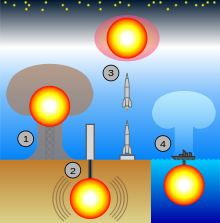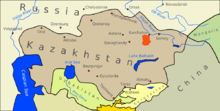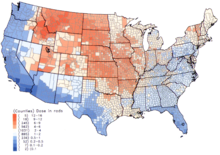From Wikipedia, the free encyclopedia
| Nuclear weapons |
|---|
 |
| Background |
| Nuclear-armed states |
| NPT recognized |
| Other |
|
| Former |
| Weapons of mass destruction |
|---|
 |
| By type |
| By country |
| Proliferation |
| Treaties |
The first nuclear weapon was detonated as a test by the United States at the Trinity site on July 16, 1945, with a yield approximately equivalent to 20 kilotons of TNT. The first hydrogen bomb, codenamed "Mike", was tested at the Enewetak atoll in the Marshall Islands on November 1, 1952 (local date), also by the United States. The largest nuclear weapon ever tested was the "Tsar Bomba" of the Soviet Union at Novaya Zemlya on October 30, 1961, with the largest yield ever seen (as of December 2013), an estimated 50–58 megatons.
In 1963, three (UK, US, Soviet Union) of the four nuclear states and many non-nuclear states signed the Limited Test Ban Treaty, pledging to refrain from testing nuclear weapons in the atmosphere, underwater, or in outer space. The treaty permitted underground nuclear testing. France continued atmospheric testing until 1974, and China continued until 1980. Neither has signed the treaty.[1]
Underground tests in the United States continued until 1992 (its last nuclear test), the Soviet Union until 1990, the United Kingdom until 1991, and both China and France until 1996. In signing the Comprehensive Test Ban Treaty in 1996, these states have pledged to discontinue all nuclear testing. However, as of December 2013, the treaty has not yet entered into force because of failure to be signed/ratified by eight specific countries. Non-signatories India and Pakistan last tested nuclear weapons in 1998.
The most recent nuclear test occurred in February 2013 in North Korea. In January 2013, North Korea had announced that it planned to conduct further tests involving rockets that can carry satellites as well as nuclear warheads "to strike and attack the United States".[2]
Contents
Types

Four major types of nuclear testing: 1. atmospheric, 2. underground, 3. exoatmospheric, and 4. underwater
- Atmospheric testing designates explosions that take place in the atmosphere. Generally these have occurred as devices detonated on towers, balloons, barges, islands, or dropped from airplanes, and also those which are only buried far enough to intentionally create a surface-breaking crater. Nuclear explosions that are close enough to the ground to draw dirt and debris into their mushroom cloud can generate large amounts of nuclear fallout due to irradiation of the debris. This definition of atmospheric follows that used in the Limited Test Ban Treaty, which banned this class of testing along with exoatmospheric and underwater.
- Underground testing refers to nuclear tests conducted under the surface of the earth, at varying depths. Underground nuclear testing made up the majority of nuclear tests by the United States and the Soviet Union during the Cold War; other forms of nuclear testing were banned by the Limited Test Ban Treaty in 1963. True underground tests are intended to be fully contained and emit a negligible amount of fallout. Unfortunately these nuclear tests do occasionally "vent" to the surface, producing from nearly none to considerable amounts of radioactive debris as a consequence. Underground testing almost by definition result in seismic activity which magnitude depends on the yield of the nuclear device and the composition of the medium it is detonated in, and generally result in the creation of subsidence craters.[3] In 1976, the United States and the USSR agreed to limit the maximum yield of underground tests to 150 kt with the Threshold Test Ban Treaty.
- Exoatmospheric testing refers to nuclear tests conducted above the atmosphere. The test devices are lifted on rockets. These high altitude nuclear explosions can generate a nuclear electromagnetic pulse (NEMP) when they occur in the ionosphere, and charged particles resulting from the blast can cross hemispheres following geomagnetic lines of force to create an auroral display.
- Underwater testing results from nuclear devices being detonated underwater, usually moored to a ship or a barge (which is subsequently destroyed by the explosion). Tests of this nature have usually been conducted to evaluate the effects of nuclear weapons against naval vessels (such as in Operation Crossroads), or to evaluate potential sea-based nuclear weapons (such as nuclear torpedoes or depth-charges). Underwater tests close to the surface can disperse large amounts of radioactive particles in water and steam, contaminating nearby ships or structures, though they generally do not create fallout other than very local to the explosion.
Salvo Tests
Another way to classify nuclear tests are by the number of explosions which constitute the test. The treaty definition of a salvo test is:"In conformity with treaties between the United States and the Soviet Union, a salvo is defined, for multiple explosions for peaceful purposes, as two or more separate explosions where a period of time between successive individual explosions does not exceed 5 seconds and where the burial points of all explosive devices can be connected by segments of straight lines, each of them connecting two burial points, and the total length does not exceed 40 kilometers. For nuclear weapon tests, a salvo is defined as two or more underground nuclear explosions conducted at a test site within an area delineated by a circle having a diameter of two kilometers and conducted within a total period of time of 0.1 second."[4]
The USSR has exploded up to eight devices in a single salvo test; Pakistan's second and last official test exploded four different devices. Almost all lists in the literature are lists of tests; in the lists in Wikipedia, (for example, Operation Cresset has separate items for Cremino and Caerphilly, which together constitute a single test) the lists are of explosions.
Purpose
Separately from these designations, nuclear tests are also often categorized by the purpose of the test itself.- Weapons-related tests are designed to garner information about how (and if) the weapons themselves work. Some serve to develop and validate a specific weapon type. Others test experimental concepts or are physics experiments meant to gain fundamental knowledge of the processes and materials involved in nuclear detonations.
- Weapons effects tests are designed to gain information about the effects of the weapons on structures, equipment, organisms and the environment. They are mainly used to assess and improve survivability to nuclear explosions in civilian and military contexts, tailor weapons to their targets, and develop the tactics of nuclear warfare.
- Safety experiments are designed to study the behavior of weapons in simulated accident scenarios. In particular, they are used to verify that a (significant) nuclear detonation cannot happen by accident. They include one-point safety tests and simulations of storage and transportation accidents.
- Nuclear test detection experiments are designed to improve the capabilities to detect, locate, and identify nuclear detonations, in particular to monitor compliance with test-ban treaties. In the United States these tests are associated with Operation Vela Uniform before the Comprehensive Test Ban Treaty stopped all nuclear testing among signatories.
- Peaceful nuclear explosions were conducted to investigate non-military applications of nuclear explosives. In the United States these were performed under the umbrella name of Operation Plowshare.
Alternatives to full-scale testing
Critical mass experiments determine the quantity of fissile material required for criticality with a variety of fissile material compositions, densities, shapes, and reflectors. They can be sub-critical or super-critical, in which case significant radiation fluxes can be produced. This type of test resulted in several criticality accidents.
Sub-critical (or cold) tests are any type of tests involving nuclear materials and possibly high-explosives (like those mentioned above) that purposefully result in no yield. The name refers to the lack of creation of a critical mass of fissile material. They are the only type of tests allowed under the interpretation of the Comprehensive Nuclear-Test-Ban Treaty tacitly agreed to by the major atomic powers.[6][7] Sub-critical tests continue to be performed by the United States, Russia, and the People's Republic of China, at least.[8][9]
Subcritical test executed by the United States include:[10][11][12]
History

The Phoenix of Hiroshima (foreground) in Hong Kong Harbor in 1967, was involved in several famous anti-nuclear protest voyages against nuclear testing in the Pacific.

The 18,000 km2 expanse of the Semipalatinsk Test Site (indicated in red), attached to Kurchatov (along the Irtysh river). The site comprised an area the size of Wales.[15]
The United States conducted six atomic tests before the Soviet Union developed their first atomic bomb (RDS-1) and tested it on August 29, 1949. Neither country had very many atomic weapons to spare at first, and so testing was relatively infrequent (when the U.S. used two weapons for Operation Crossroads in 1946, they were detonating over 20% of their current arsenal). However, by the 1950s the United States had established a dedicated test site on its own territory (Nevada Test Site) and was also using a site in the Marshall Islands (Pacific Proving Grounds) for extensive atomic and nuclear testing.
The early tests were used primarily to discern the military effects of atomic weapons (Crossroads had involved the effect of atomic weapons on a navy, and how they functioned underwater) and to test new weapon designs. During the 1950s, these included new hydrogen bomb designs, which were tested in the Pacific, and also new and improved fission weapon designs. The Soviet Union also began testing on a limited scale, primarily in Kazakhstan. During the later phases of the Cold War, though, both countries developed accelerated testing programs, testing many hundreds of bombs over the last half of the 20th century.

In 1954 the Castle Bravo fallout plume spread dangerous levels of radiation over an area over 100 miles long, including inhabited islands.

Because of concerns about worldwide fallout levels, the Partial Test Ban Treaty was signed in 1963. Above are the per capita thyroid doses (in rads) in the continental United States resulting from all exposure routes from all atmospheric nuclear tests conducted at the Nevada Test Site from 1951–1962.
Almost all new nuclear powers have announced their possession of nuclear weapons with a nuclear test. The only acknowledged nuclear power which claims never to have conducted a test was South Africa (see Vela Incident), which has since dismantled all of its weapons. Israel is widely thought to possess a sizable nuclear arsenal, though it has never tested, unless they were involved in Vela. Experts disagree on whether states can have reliable nuclear arsenals—especially ones using advanced warhead designs, such as hydrogen bombs and miniaturized weapons—without testing, though all agree that it is very unlikely to develop significant nuclear innovations without testing. One other approach is to use supercomputers to conduct "virtual" testing, but codes need to be validated against test data.
There have been many attempts to limit the number and size of nuclear tests; the most far-reaching is the Comprehensive Test Ban Treaty of 1996, which has not, as of 2013, been ratified by eight of the "Annex 2 countries" required for it to take effect, including the United States. Nuclear testing has since become a controversial issue in the United States, with a number of politicians saying that future testing might be necessary to maintain the aging warheads from the Cold War. Because nuclear testing is seen as furthering nuclear arms development, many are opposed to future testing as an acceleration of the arms race.
-
The first atomic test, "Trinity", took place on July 16, 1945.
-
The Sedan test of 1962 was an experiment by the United States in using nuclear weapons to excavate large amounts of earth.
Nuclear testing by country
Main articles: List of nuclear weapons tests and France and weapons of mass destruction

Over 2,000 nuclear tests have been conducted, in over a dozen different
sites around the world. Red Russia/Soviet Union, blue France, light blue
United States, violet Britain, black Israel, orange China, yellow
India, brown Pakistan, green North Korea and light green (territories
exposed to nuclear bombs)

"Baker Shot", part of Operation Crossroads, a nuclear test by the United States at Bikini Atoll in 1946
 United States: 1,054 tests by official count (involving at least 1,149 devices). 219 were atmospheric tests as defined by the CTBT. These tests include 904 at the Nevada Test Site, 106 at the Pacific Proving Grounds and other locations in the Pacific, 3 in the South Atlantic Ocean, and 17 other tests taking place in Amchitka Alaska, Colorado, Mississippi, New Mexico and Nevada outside the NNSS (see Nuclear weapons and the United States
for details). 24 tests are classified as British tests held at the NTS.
There are 35 Plowshare detonations and 7 Vela Uniform tests; 88 tests
were safety experiments and 4 were transportation/storage tests.[16] Link to United States' table data
United States: 1,054 tests by official count (involving at least 1,149 devices). 219 were atmospheric tests as defined by the CTBT. These tests include 904 at the Nevada Test Site, 106 at the Pacific Proving Grounds and other locations in the Pacific, 3 in the South Atlantic Ocean, and 17 other tests taking place in Amchitka Alaska, Colorado, Mississippi, New Mexico and Nevada outside the NNSS (see Nuclear weapons and the United States
for details). 24 tests are classified as British tests held at the NTS.
There are 35 Plowshare detonations and 7 Vela Uniform tests; 88 tests
were safety experiments and 4 were transportation/storage tests.[16] Link to United States' table data
 Soviet Union: 715 tests (involving 969 devices) by official count, plus 13 unnumbered test failures.[17][18] Most were at their Southern Test Area at Semipalatinsk Test Site and the Northern Test Area at Novaya Zemlya. Others include rocket tests and peaceful-use explosions at various sites in Russia, Kazakhstan, Turkmenistan, Uzbekistan and Ukraine. Link to Soviet Union's table data
Soviet Union: 715 tests (involving 969 devices) by official count, plus 13 unnumbered test failures.[17][18] Most were at their Southern Test Area at Semipalatinsk Test Site and the Northern Test Area at Novaya Zemlya. Others include rocket tests and peaceful-use explosions at various sites in Russia, Kazakhstan, Turkmenistan, Uzbekistan and Ukraine. Link to Soviet Union's table data
 United Kingdom: 45 tests (21 in Australian territory, including three at the Montebello Islands, nine in mainland South Australia at Maralinga and Emu Field, some at Christmas Island (Kirimati) in the Pacific Ocean, plus 24 in the United States at the Nevada Test Site as part of joint test series)[19] 43 safety tests (the Vixen series) are not included in that number, though safety experiments by other countries are. Link to Great Britain's summary table
United Kingdom: 45 tests (21 in Australian territory, including three at the Montebello Islands, nine in mainland South Australia at Maralinga and Emu Field, some at Christmas Island (Kirimati) in the Pacific Ocean, plus 24 in the United States at the Nevada Test Site as part of joint test series)[19] 43 safety tests (the Vixen series) are not included in that number, though safety experiments by other countries are. Link to Great Britain's summary table
 France: 210 tests by official count (50 atmospheric, 160 underground[20]), four atomic atmospheric tests at C.E.S.M. near Reggane, 13 atomic underground tests at C.E.M.O. near In Ekker in the French Algerian Sahara, and nuclear atmospheric and underground tests at and around Fangataufa and Moruroa Atolls in French Polynesia.
Four of the In Ekker tests are counted as peaceful use, as they were
reported as part of the CET's APEX (Application pacifique des
expérimentations nucléaires), and given alternate names. Link to France's summary table
France: 210 tests by official count (50 atmospheric, 160 underground[20]), four atomic atmospheric tests at C.E.S.M. near Reggane, 13 atomic underground tests at C.E.M.O. near In Ekker in the French Algerian Sahara, and nuclear atmospheric and underground tests at and around Fangataufa and Moruroa Atolls in French Polynesia.
Four of the In Ekker tests are counted as peaceful use, as they were
reported as part of the CET's APEX (Application pacifique des
expérimentations nucléaires), and given alternate names. Link to France's summary table
 China: 45 tests (23 atmospheric and 22 underground), at Lop Nur Nuclear Weapons Test Base, in Malan, Xinjiang[21] There are two additional unnumbered failed tests. Link to China's summary table
China: 45 tests (23 atmospheric and 22 underground), at Lop Nur Nuclear Weapons Test Base, in Malan, Xinjiang[21] There are two additional unnumbered failed tests. Link to China's summary table
 India: six underground explosions (including the first one in 1974), at Pokhran. Link to India's summary table
India: six underground explosions (including the first one in 1974), at Pokhran. Link to India's summary table
 Pakistan: seven underground explosions at Ras Koh Hills and the Chagai District.[22] Link to Pakistan's summary table
Pakistan: seven underground explosions at Ras Koh Hills and the Chagai District.[22] Link to Pakistan's summary table
 North Korea: three underground tests at the Punggye-ri Nuclear Test Site. Link to North Korea's summary table
North Korea: three underground tests at the Punggye-ri Nuclear Test Site. Link to North Korea's summary table
From the first nuclear test in 1945 until tests by Pakistan in 1998, there was never a period of more than 22 months with no nuclear testing. June 1998 to October 2006 was the longest period since 1945 with no acknowledged nuclear tests.



No comments:
Post a Comment